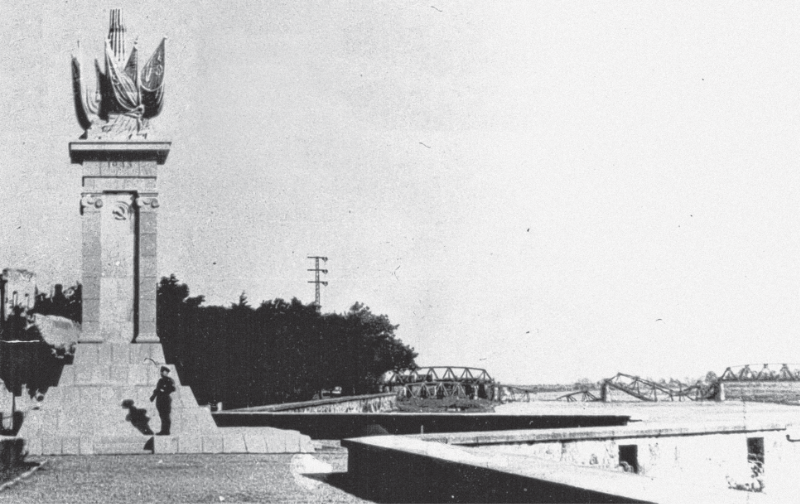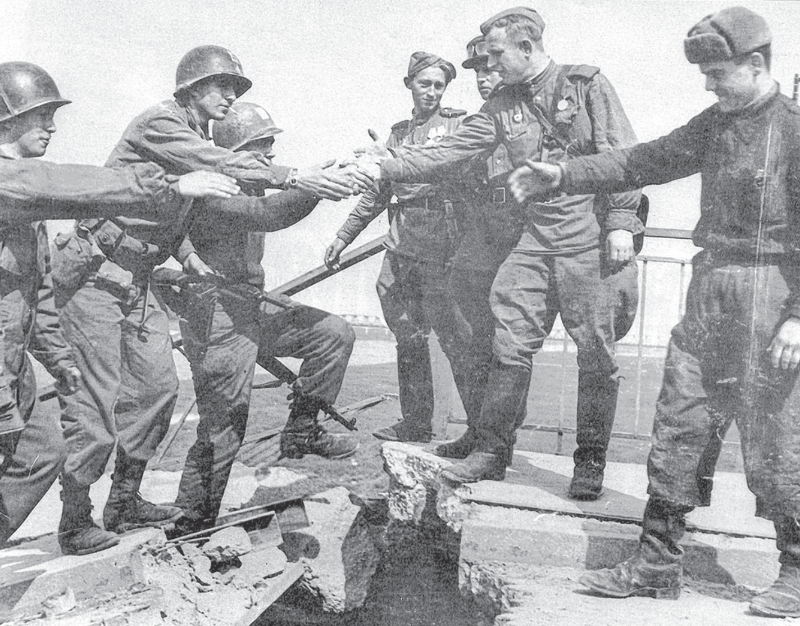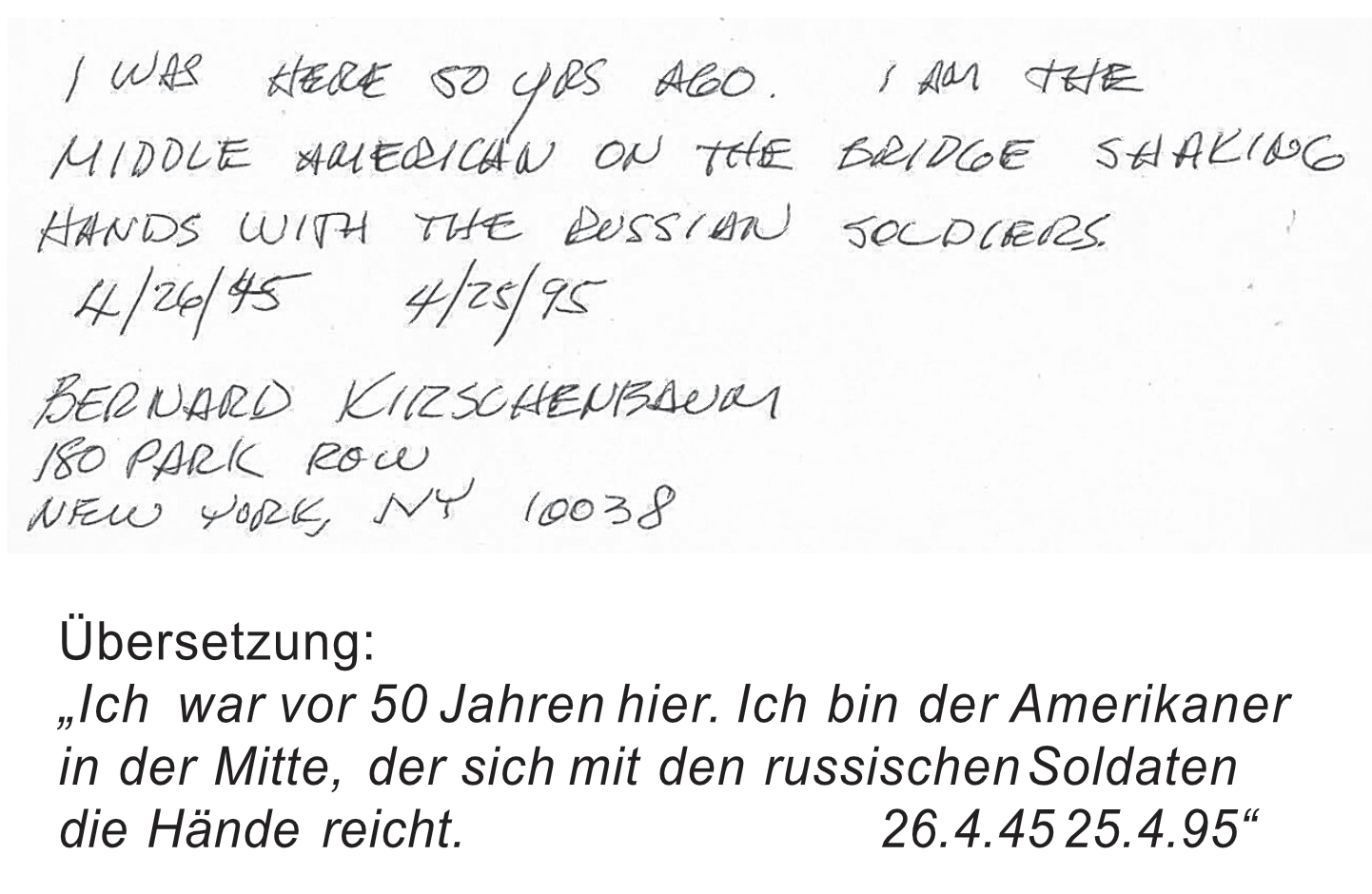
75 years Elbe meeting (Part 1)
The field of corpses of Lorenzkirch / Joseph Polowsky and the Oath of Peace
In a four-part series, Dr. Uwe Niedersen, member of the board of the Förderverein Europa Begegnungen,
deals with the Elbe meeting on its 75th anniversary. His thesis: Torgau remains well below its potential, both internally and externally.
Within the series Niedersen draws a blueprint based on which a better Torgau can be created.
Torgau.
This article had been written by me (U. N.) during the early Elbe-Day preparations of the Förderverein Europa Begegnungen e. V., well before the Corona virus epidemic.
The statements contained in the following text might be of little interest to the reader due to the present unusual situation. The virus currently determines the daily routine. It is certain however, that being for oneself, isolation, reading and reflection will give more opportunities again. And, our Torgau will still exist after the virus.
I leave my thoughts here, so they won't be forgotten.
Let us start the search for abetter Torgau today.
The reason for doing this is the meeting of Soviet and American troops near Torgau on the Elbe, which took place just 75 years ago.
At the beginning of the year, following the call of Mayor Romina Barth to help shape the 75th anniversary of the Elbe meeting in a dignified and meaningful way, the members of the Förderverein Europa Begegnungen e. V. got back in touch with Joseph Polowsky, for a reason.
On the one hand, we were interested in his writing "Principia", the contents of which we in Torgau are not familiar with.
On the other hand, there was a speech that had become known to us, presented by the American Senator Paul Simon in the Senate of the United States of America in 1985 at the 40th anniversary of the end of the war in honor of Joseph Polowsky's life accomplishments.
The Senator's important speech was groundbreaking to the reflections on humanism by Joseph Polowsky that begun to emerge in our association. The speech has touched our image of Polowsky in the Association fundamentally, with corresponding effects::
In the text of the senator's speech we came across some important, but hardly expressed insights so far.
As is well known, Polowsky has always been approachable, even as a soldier, with regard to ethical values; indeed, even in the harshest situations of the war, his humanistic attitudes towards life were preserved.
As a fact of the matter be mentioned:
At the very moment of his meeting with the Soviets, around noon on April 25, 1945, in the middle of a field of corpses with about 200 dead civilians on the Elbe meadow in Lorenzkirch, he saw a little girl stretched outlifelessly. The girl at the side of her dead mother pressed her doll to herself with one arm and held crayons in the other hand. Most of the dead people there were probably refugees from the areas between the Elbe and the Oder/ Neisse.
This surroundings, so shocking and impressive, taken at the site of the first East-West meeting of two armies on the Elbe, led the American soldier Polowsky together with Soviet fighters, who were also affected, to draft a peace declaration. They promised each other that they would do everything possible to prevent people from striking each other after the war: "The people should, indeed must, live in peace! The confession and articulation of feelings of Soviet and American soldiers in the face of Lorenzkirch's corpse field is also known as the "Oath of Peace from the Elbe".
Now, once more to the speech before the United States senate:
Paul Simon's speech before the United States Senate finally reached its climax when the lecturer exclaimed that he not only wanted to commemorate the Allied military heroes who gave their lives for peace but also to honor the millions of innocent civilian victims of the Second World War, as their lives would otherwise fall into general oblivion. In the climax of his speech, the Senator described all the countless civilian victims of the war as "the millions Polowskys" and said:
It was a "keepsake of the millions of Polowskys."
The millions of Polowskys were for the Senator the millions of Civilians who died in the war. The millions Polowskys were, according to Paul Simon, those Victims whom Polowsky told about the Girl with the doll symbolically as their former being and their dignity. Polowsky looking at the girl in the field of corpses helped to create the special symbol and the truthfulness of victims that had found entry into the history books.
Moreover, Sebnator Paul saw the million Polowsky’s, and he expressed particularly that he saw it in “Anne Frank, Tanja Sawitschewa and all the young girls that died with a doll in their hands”. Anne Frank has been the Jewish girl from Germany living through WW II in a Dutch hideout and being killed in a concentration camp.
Tanya Savicheva was a Russian Girl who was killed in Leningrad surrounden by German troops. She also wrote a renown diary where she described the tragedy of being locked-in and thereby starving to death.
The American senator Paul Simon from the state of Illinois (USA) added the symbol of the unknown girl lying lifeless with her doll on the Elbe meadow of Lorenzkirch, near the city of Torgau, to these two well-known victim pictures. Now let me tell you about a significant episode from those April war days:
In 1995, an American visitor to our town signed the guest book of the Tourist and Information Centre (TIC) during Elbe Day. He was the Torgau Elbe meeting veteran Bernard Kirschenbaum, once a soldier on the staff of the regimental commander Colonel Adams, a member of the 69th US Infantry Division. Kirschenbaum is the person in the middle of the world-famous meeting photo in Torgau, shaking hands with the Soviets. Kirschenbaum has passed away already, but we have contacted his daughter Sara. She told us about a deep shock her father had to experience when he entered the concentration camp Abtnaundorf near Leipzig in spring 1945. Bernard Kirschenbaum was haunted by the sight of a dead two-year-old girl on the ground in front of him. Over the years, this cruel, shocking image stuck with him, it became so entrenched to him that the trauma associated with it affected his family.
Because of the "multiplication" of a terrible reality we ask in general.
Is the picture of a "little, innocent, killed girl", which is surrounded by a special tragedy a fundamental symbol that refers us to "evil itself"? Would we have to discuss this with psychologists, theologians and other experts?
Additionally, we add the question:
How did evil actually come into the world? Sara Kirschenbaum and the Förderverein Europa Begegnungen e. V. want to exchange views on this as a first step.
In the next part you can read how Jerusalem became aware of Torgau and why it was good to not (yet) accept an invitation from there.
BACKGROUND
The Förderverein Europa Begegnungen e. V. deals with meetings in history. Primarily those in which our hometown was historically integrated into the world. Luther, Cranach, Peter I of Russia, Leibniz, Frederick the Great, Napoleon, even the soldiers of 1945 who reached out their hands, they all have been in Torgau. The Förderverein Europa Begegnungen e. V. offers independent staff and intellectual potential together with its external contacts views to the international history of the city. During the Luther Decade, we worked nationwide on the topic of "Torgau, the political centre of the Lutheran Reformation". We succeeded in understanding the 500-year old red chalk inscriptions in the Wendelstein and presented them comprehensively to the public, and we were internationally successful with the series: Torgau Fortress, Napoleon and field battles. Finally, we have also written down the history of the soldiers who operated on the Elbe at the end of the war in 1945, in a scientifically comprehensive manner and with strict attention to the truthfulness of the events of that time. It should be added that even the local industrial culture (fuse factory) became a topic for us. Because there is a profound potential for information in all this Torgau content, we have started to deal with the historical-theoretical view as well. We maintain connections to first-rate historical-theoretical institutions and specialists in Germany and abroad. This is especially true for the topic "The Individual and Reality", which has just been taken up and which was revealed to us during the Luther Decade through special historical persons and their spheres of influence, such as Luther and the Church, Cranach and the Arts, as well as Elector Johann Friedrich and the State.
The statements contained in the following text might be of little interest to the reader due to the present unusual situation. The virus currently determines the daily routine. It is certain however, that being for oneself, isolation, reading and reflection will give more opportunities again. And, our Torgau will still exist after the virus.
I leave my thoughts here, so they won't be forgotten.
Let us start the search for abetter Torgau today.
The reason for doing this is the meeting of Soviet and American troops near Torgau on the Elbe, which took place just 75 years ago.
Reasonable grounds
At the beginning of the year, following the call of Mayor Romina Barth to help shape the 75th anniversary of the Elbe meeting in a dignified and meaningful way, the members of the Förderverein Europa Begegnungen e. V. got back in touch with Joseph Polowsky, for a reason.
On the one hand, we were interested in his writing "Principia", the contents of which we in Torgau are not familiar with.
On the other hand, there was a speech that had become known to us, presented by the American Senator Paul Simon in the Senate of the United States of America in 1985 at the 40th anniversary of the end of the war in honor of Joseph Polowsky's life accomplishments.
The Senator's important speech was groundbreaking to the reflections on humanism by Joseph Polowsky that begun to emerge in our association. The speech has touched our image of Polowsky in the Association fundamentally, with corresponding effects::
In the text of the senator's speech we came across some important, but hardly expressed insights so far.
As is well known, Polowsky has always been approachable, even as a soldier, with regard to ethical values; indeed, even in the harshest situations of the war, his humanistic attitudes towards life were preserved.
As a fact of the matter be mentioned:
At the very moment of his meeting with the Soviets, around noon on April 25, 1945, in the middle of a field of corpses with about 200 dead civilians on the Elbe meadow in Lorenzkirch, he saw a little girl stretched outlifelessly. The girl at the side of her dead mother pressed her doll to herself with one arm and held crayons in the other hand. Most of the dead people there were probably refugees from the areas between the Elbe and the Oder/ Neisse.
Shocking and memorable
This surroundings, so shocking and impressive, taken at the site of the first East-West meeting of two armies on the Elbe, led the American soldier Polowsky together with Soviet fighters, who were also affected, to draft a peace declaration. They promised each other that they would do everything possible to prevent people from striking each other after the war: "The people should, indeed must, live in peace! The confession and articulation of feelings of Soviet and American soldiers in the face of Lorenzkirch's corpse field is also known as the "Oath of Peace from the Elbe".
Now, once more to the speech before the United States senate:
Paul Simon's speech before the United States Senate finally reached its climax when the lecturer exclaimed that he not only wanted to commemorate the Allied military heroes who gave their lives for peace but also to honor the millions of innocent civilian victims of the Second World War, as their lives would otherwise fall into general oblivion. In the climax of his speech, the Senator described all the countless civilian victims of the war as "the millions Polowskys" and said:
It was a "keepsake of the millions of Polowskys."
The millions of Polowskys were for the Senator the millions of Civilians who died in the war. The millions Polowskys were, according to Paul Simon, those Victims whom Polowsky told about the Girl with the doll symbolically as their former being and their dignity. Polowsky looking at the girl in the field of corpses helped to create the special symbol and the truthfulness of victims that had found entry into the history books.
Moreover, Sebnator Paul saw the million Polowsky’s, and he expressed particularly that he saw it in “Anne Frank, Tanja Sawitschewa and all the young girls that died with a doll in their hands”. Anne Frank has been the Jewish girl from Germany living through WW II in a Dutch hideout and being killed in a concentration camp.
Tanya Savicheva was a Russian Girl who was killed in Leningrad surrounden by German troops. She also wrote a renown diary where she described the tragedy of being locked-in and thereby starving to death.
An important episode
The American senator Paul Simon from the state of Illinois (USA) added the symbol of the unknown girl lying lifeless with her doll on the Elbe meadow of Lorenzkirch, near the city of Torgau, to these two well-known victim pictures. Now let me tell you about a significant episode from those April war days:
In 1995, an American visitor to our town signed the guest book of the Tourist and Information Centre (TIC) during Elbe Day. He was the Torgau Elbe meeting veteran Bernard Kirschenbaum, once a soldier on the staff of the regimental commander Colonel Adams, a member of the 69th US Infantry Division. Kirschenbaum is the person in the middle of the world-famous meeting photo in Torgau, shaking hands with the Soviets. Kirschenbaum has passed away already, but we have contacted his daughter Sara. She told us about a deep shock her father had to experience when he entered the concentration camp Abtnaundorf near Leipzig in spring 1945. Bernard Kirschenbaum was haunted by the sight of a dead two-year-old girl on the ground in front of him. Over the years, this cruel, shocking image stuck with him, it became so entrenched to him that the trauma associated with it affected his family.
Because of the "multiplication" of a terrible reality we ask in general.
Is the picture of a "little, innocent, killed girl", which is surrounded by a special tragedy a fundamental symbol that refers us to "evil itself"? Would we have to discuss this with psychologists, theologians and other experts?
Additionally, we add the question:
How did evil actually come into the world? Sara Kirschenbaum and the Förderverein Europa Begegnungen e. V. want to exchange views on this as a first step.
In the next part you can read how Jerusalem became aware of Torgau and why it was good to not (yet) accept an invitation from there.
BACKGROUND
The Förderverein Europa Begegnungen e. V. deals with meetings in history. Primarily those in which our hometown was historically integrated into the world. Luther, Cranach, Peter I of Russia, Leibniz, Frederick the Great, Napoleon, even the soldiers of 1945 who reached out their hands, they all have been in Torgau. The Förderverein Europa Begegnungen e. V. offers independent staff and intellectual potential together with its external contacts views to the international history of the city. During the Luther Decade, we worked nationwide on the topic of "Torgau, the political centre of the Lutheran Reformation". We succeeded in understanding the 500-year old red chalk inscriptions in the Wendelstein and presented them comprehensively to the public, and we were internationally successful with the series: Torgau Fortress, Napoleon and field battles. Finally, we have also written down the history of the soldiers who operated on the Elbe at the end of the war in 1945, in a scientifically comprehensive manner and with strict attention to the truthfulness of the events of that time. It should be added that even the local industrial culture (fuse factory) became a topic for us. Because there is a profound potential for information in all this Torgau content, we have started to deal with the historical-theoretical view as well. We maintain connections to first-rate historical-theoretical institutions and specialists in Germany and abroad. This is especially true for the topic "The Individual and Reality", which has just been taken up and which was revealed to us during the Luther Decade through special historical persons and their spheres of influence, such as Luther and the Church, Cranach and the Arts, as well as Elector Johann Friedrich and the State.

The recently built monument on the Elbe with the blown-up railway bridge, architect Abraham Milezkij. The photo was taken by him in summer 1945.


Above: Meeting photo with Bernard Kirschenbaum (2nd from left); below: Kirschenbaum entry in the TIC guestbook.) Repros: Förderverein Europa Begegnungen e. V.